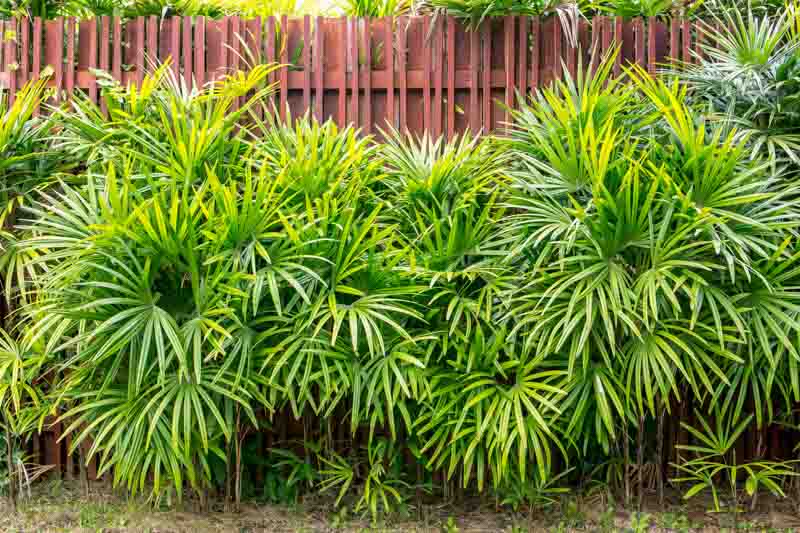Ground Rattan, Bamboo Palm, Lady Palm, Miniature Fan Palm, Fern Rhapis, Rhapis flabelliformis, Chamaerops excelsa, Trachycarpus excelsa
Rhapis excelsa, commonly known as the Lady Palm, is a sophisticated and versatile palm that enhances indoor and outdoor spaces with its elegance and ease of care.
The Lady Palm features dark green, fan-shaped leaves divided into broad, ribbed segments emanating from multiple, thin trunks covered in fibrous material. This slow-growing palm is celebrated for its refined appearance and air-purifying qualities.
Native: Native to the forest floors of China and Taiwan, Rhapis excelsa thrives under the canopy’s dappled light and adapts well to various environmental conditions. It belongs to the palm family (Arecaceae), like the Christmas Palm, Majesty Palm, or Areca Palm.
Plant Type and Habit: Lady Palm is a small evergreen palm with upright, slender, bamboo-like canes bearing delicate, glossy, dark green, fan-shaped leaves. The sturdy canes are covered with brown fibers which fall as the plant ages, revealing the bamboo-like trunks.
Size: In indoor settings, Rhapis excelsa typically reaches 4-6 feet in height (120-180 cm) but can grow 6-15 feet tall and wide (180-450 cm) in its natural habitat or when planted outdoors in favorable climates. This palm spreads by rhizome offshoots.
Flowers: Though flowering is rare in indoor environments, the Lady Palm produces small panicles of tiny yellow flowers in summer that can be hidden within its foliage in outdoor settings. Following flowering, it can produce small, round fruits, though this is uncommon, particularly in indoor cultivation.
Foliage: Its foliage is the plant’s standout feature, with glossy, dark green leaves that can add a touch of sophistication to any space. Each leaf is about 20 inches long (50 cm) and divided into 5-10 narrowly oblong lobes.
Hardiness: Rhapis excelsa is hardy in USDA zones 9-11 when planted outdoors. It can withstand temperatures down to 18ºF (-7ºC) for short periods. However, it is best not to expose the plant to temperatures below 35°F (2°C) for optimal health and growth.
Award: Recipient of the prestigious Award of Garden Merit of the Royal Horticultural Society.
Uses: Ridiculously easy to grow, the Lady Palm is popular as a houseplant, lending a rich tropical look to the home. It is also useful as a foundation plant, privacy screen and quite effective as an accent in a shrub border.
Drought Tolerance: Though it prefers consistent moisture, Rhapis excelsa can tolerate short periods of drought once established, making it relatively easy to care for in various environments.
Deer and Rabbit: Its resistance to deer and rabbits adds to its appeal for outdoor planting in areas where these creatures are prevalent.
Toxicity: The Lady Palm is non-toxic to humans and pets, making it a safe choice for households and animal-friendly gardens.
Invasiveness: This palm is not considered invasive. Its slow growth and clumping nature keep it contained within its planting area.
Benefits: Beyond its aesthetic appeal, the Lady Palm is known for its air-purifying capabilities, removing toxins from indoor environments and improving air quality.

Growing and caring for Rhapis excelsa, commonly known as the Lady Palm, involves understanding its natural habitat and replicating those conditions as closely as possible.
Light: Rhapis excelsa prefers bright, indirect light but can tolerate lower light levels, making it an excellent choice for indoor spaces. While the Lady Palm can tolerate low light, providing it with bright, indirect light will encourage more vigorous growth and healthier foliage. It’s important to avoid direct sunlight, as this can scorch its leaves.
Soil: Use a well-draining potting mix rich in organic matter. A mix designed for palms or a general-purpose potting soil amended with perlite and peat moss is suitable.
Water: Water the Lady Palm when the top inch of soil becomes dry to the touch. Ensure the pot has good drainage to prevent waterlogging, which can lead to root rot. During the winter months, reduce watering frequency as growth slows.
Temperature and Humidity: Keep the plant away from cold drafts and maintain a consistent temperature within its preferred range (60°F to 80°F or 15°C to 27°C). While Rhapis excelsa can tolerate less humid conditions, it thrives in higher humidity. Mist the leaves regularly, use a pebble tray, or place a humidifier nearby to increase humidity, especially in dry indoor environments.
Fertilization: Feed your Lady Palm with a balanced, slow-release fertilizer formulated for palms or indoor plants during the growing season (spring through summer). Do not overfertilize, as this can harm the plant.
Pruning: Prune any brown or damaged fronds at the base to maintain the plant’s appearance and health. Regular pruning also encourages new growth.
Cleaning: Clean the leaves occasionally with a damp cloth to remove dust and support efficient photosynthesis.
Repotting: Repot the Lady Palm every 2-3 years or when it becomes root-bound. Choose a pot only slightly larger than the current one to avoid excessively damp soil, which can harm the plant.
Light: Choose a location that receives partial shade to filtered sunlight. Tolerates close to full shade. Plants grown in direct sun tend to fade to yellow-green and burn if not provided adequate moisture.
Soil: The Lady Palm prefers well-draining soil rich in organic matter. Amend the planting site with compost to improve soil structure and fertility if necessary. Ensure the planting area does not collect standing water, as this can lead to root rot.location that receives partial shade to filtered sunlight. Too much direct sunlight can scorch the leaves.
Planting: When planting Rhapis excelsa, dig a hole twice as wide but just as deep as the root ball. This allows the roots to spread easily. Space multiple plants at least 3-4 feet apart (90-120 cm) to accommodate their spread and ensure adequate airflow.
Water: Water your Lady Palm regularly to keep the soil consistently moist but not waterlogged, especially during the warmer months. Reduce watering frequency during the cooler months but do not let the soil dry out completely.
Temperature: Rhapis excelsa is hardy in USDA zones 9-11. In these climates, it can be grown outdoors year-round.
Fertilization: Apply a balanced, slow-release palm fertilizer in the spring and summer to support healthy growth. Follow the manufacturer’s instructions for application rates. Do not over-fertilize, as this can damage the plant.
Pruning: Prune any yellow or brown fronds to maintain the plant’s appearance and health. Use clean, sharp pruning shears to make clean cuts. Remove any debris from around the base of the plant to discourage pests and diseases.
Mulching: Apply a 2-3 inch layer (5-7 cm) of organic mulch around the base of the plant to help retain soil moisture, regulate soil temperature, and reduce weed competition. Keep the mulch a few inches away from the trunk to prevent rot.
Protection: In areas prone to frost or if a cold snap is expected, provide protection with frost cloths or move potted specimens indoors to a garage or similar frost-free area until the risk of frost has passed.

Propagating Rhapis excelsa or Lady Palm is typically done through division, as it produces offshoots or “pups” from its base. This method allows gardeners to create new plants that are genetically identical to the parent. Here’s a step-by-step guide to propagating Lady Palm through division:
Timing: The best time to propagate Lady Palm is in the spring or early summer when the plant is entering a period of active growth.
Preparation: Before you start, make sure you have pots filled with well-draining potting mix ready for the divisions. Choose a potting mix suitable for palms or a general-purpose potting soil mixed with perlite or sand to improve drainage.
Removing the Plant: Carefully remove the Lady Palm from its pot or dig around the base of the plant if it’s in the ground. Try to minimize root disturbance as much as possible.
Identifying Divisions: Look for natural divisions in the plant where offshoots have formed their own root systems. These offshoots are the parts you’ll separate to create new plants.
Division: Using a clean, sharp knife or a pair of pruning shears, gently separate the offshoots from the main plant. Ensure each division has a portion of the root system intact. If the roots are densely tangled, you may need to carefully untangle them or cut through the roots to separate the divisions. Be as gentle as possible to minimize damage.
Potting Up: Plant each division in its own pot filled with the prepared potting mix. Plant them at the same depth they were growing previously. Water the divisions well after planting to help settle the soil around the roots.
Lady Palm is generally resilient to pests and diseases, making it a robust choice for indoor and outdoor gardening. However, like all plants, it can encounter some issues.
Spider mites: These tiny pests can be a problem, especially in dry indoor environments. They cause yellowing or browning of leaves and fine webbing on the plant. Increase humidity and wash the plant with a strong stream of water. Insecticidal soap or neem oil can also be effective.
Scale Insects: Manifesting as small, brown, dome-shaped bumps on the stems and leaves, scale insects suck sap from the plant. Remove them manually with a soft cloth dipped in soapy water or use horticultural oil.
Mealybugs: These pests appear as white, cottony masses in leaf axils or on the undersides of leaves. They can be removed with a cotton swab dipped in rubbing alcohol or treated with insecticidal soap.
Root rot: Overwatering is the primary cause of root rot in Lady Palms, leading to yellowing leaves and a wilted appearance. Ensure proper drainage in pots and water only when the top inch of soil is dry.
Leaf spot diseases: Fungal and bacterial leaf spots can occur, especially in humid conditions or when leaves are wet. Improve air circulation, avoid wetting the foliage, and remove affected leaves. Fungicides can be used if necessary.
Brown Leaf Tips: This issue often results from low humidity, excess fertilizer, or fluoridated/chlorinated water. Use filtered water, reduce fertilizer application, and increase humidity around the plant.
Yellowing Leaves: Overwatering, poor drainage, or nutrient deficiencies can cause yellow leaves. Adjust your watering schedule, ensure good soil drainage, and consider a balanced, slow-release fertilizer.
Slow Growth: Inadequate light can lead to slow growth. While Lady Palms can tolerate low-light conditions, they thrive in bright, indirect light. Move your plant to a brighter location if possible.

| Hardiness |
9 - 11 |
|---|---|
| Heat Zones |
10 - 11 |
| Climate Zones | 12, 13, 14, 15, 16, 17, 19, 20, 21, 22, 23, 24, H1, H2 |
| Plant Type | Houseplants, Palms - Cycads |
| Plant Family | Arecaceae |
| Common names | Lady Palm |
| Exposure | Partial Sun, Shade |
| Season of Interest |
Spring (Early, Mid, Late) Summer (Early, Mid, Late) Fall Winter |
| Height |
6' - 15' (180cm - 4.6m) |
| Spread |
6' - 15' (180cm - 4.6m) |
| Maintenance | Low |
| Water Needs | Low |
| Soil Type | Loam |
| Soil pH | Acid, Neutral |
| Soil Drainage | Well-Drained |
| Characteristics | Plant of Merit, Showy, Evergreen |
| Tolerance | Drought, Deer, Full Shade |
| Garden Uses | Hedges And Screens, Patio And Containers |
| Garden Styles | Mediterranean Garden |
| Hardiness |
9 - 11 |
|---|---|
| Heat Zones |
10 - 11 |
| Climate Zones | 12, 13, 14, 15, 16, 17, 19, 20, 21, 22, 23, 24, H1, H2 |
| Plant Type | Houseplants, Palms - Cycads |
| Plant Family | Arecaceae |
| Common names | Lady Palm |
| Exposure | Partial Sun, Shade |
| Season of Interest |
Spring (Early, Mid, Late) Summer (Early, Mid, Late) Fall Winter |
| Height |
6' - 15' (180cm - 4.6m) |
| Spread |
6' - 15' (180cm - 4.6m) |
| Maintenance | Low |
| Water Needs | Low |
| Soil Type | Loam |
| Soil pH | Acid, Neutral |
| Soil Drainage | Well-Drained |
| Characteristics | Plant of Merit, Showy, Evergreen |
| Tolerance | Drought, Deer, Full Shade |
| Garden Uses | Hedges And Screens, Patio And Containers |
| Garden Styles | Mediterranean Garden |
How many Rhapis excelsa (Lady Palm) do I need for my garden?
| Plant | Quantity | |
|---|---|---|
| Rhapis excelsa (Lady Palm) | N/A | Buy Plants |
Create a membership account to save your garden designs and to view them on any device.
Becoming a contributing member of Gardenia is easy and can be done in just a few minutes. If you provide us with your name, email address and the payment of a modest $25 annual membership fee, you will become a full member, enabling you to design and save up to 25 of your garden design ideas.
Join now and start creating your dream garden!
Create a membership account to save your garden designs and to view them on any device.
Becoming a contributing member of Gardenia is easy and can be done in just a few minutes. If you provide us with your name, email address and the payment of a modest $25 annual membership fee, you will become a full member, enabling you to design and save up to 25 of your garden design ideas.
Join now and start creating your dream garden!